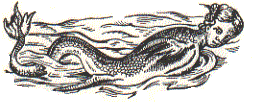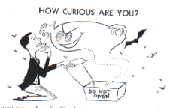Mermaid Culture
Mermaid High: Shapeshifting Hallucinations as Metaphors for Power and Transformation Through Solanaceous Intoxication
by Jeff Bagato

Metaphysically, the mermaid metaphor hybridizes consciousness and subconsciousness--what we know and recognize rising out of the mind's surface (shaped as a woman), and what we do not know descending into the depths (shaped as a fish). The mermaid can pull us into the depths, guide us into an alien world. Mermaids are on the cusp of the physical abyss of the ocean and the psychological abyss of the inner mind.
So mermaids are special countercultural figures, hybrids that belong to neither animal nor human worlds and who serve as guides to a world of dreams and freedoms--a more animal man, a more sentient animal, dangerously liberated either way. Transgressors of rationality, linked not to earth but to the sea, they are more unstable, more changeable, more hysterical, more unreliable than terrestrial things. Mermaids are not "earthy" but "oceanic." Sirens seduce one fake breitling watches into madness--away from lofty thoughts of the superego, away even from the earthly thoughts of the libido, going into the nether realms of the subconscious. Mermaids create new terms for state of being--"ocean consciousness"--as alien as "mushroom consciousness" or "peyote consciousness"--and also suggesting a drug experience. But which drug?
How does one access mermaid consciousness?
By following the siren's song.
But what is the real world analog of this song?
What is the real world gateway to mermaid lands?
Consider: The sound of ocean waves, seagull cries, hallucinogenic seafood, frog or toad toxins, blue water lily, the Wiccan brew of belladonna/henbane/mandrake/datura...
As an analog to the mermaid realms, the faerie world is accessed by ingestion of the magic mushroom, fungus being a clear part of most faerie lore and culture. Faeries gather around toadstools deep in forests, and humans are sometimes said to go there--to participate in their world. Yet there is no clear folkloric relationship between mermaid culture and psychedelic drugs, no sacred experience meant to honor a cult of the mermaid, and visitations usually move from magic to mundane worlds. This paucity of information about mermaid culture makes sense; historically, man has had no experience of oceanic life. Man has lived in the mountains, the icelands, the forests, the deserts, the coasts--but not in the sea. Humans only experience the surface of the ocean. We ride on the surface and dip into the water to pull things out. When we see a rock or a fin or a figure rising above the surface, we know something is below. Other than that, the ocean is a cipher, concealing everything from cities to sirens.1 If humans had lived in the sea, rather than on land, then there would be greater need for an access (folkloric or pharmacological) to the depths. Mermaids seem especially alien because few humans have thought to have more than a passing acquaintance with the oceanic world. Fishermen are the most likely sources of cultic activity relating to mermaids, just as they are the most frequent sources of mythical lore. Lack of knowledge with undersea life would explain why there are no clear visions extant rolex perpetual of oceanic kingdoms or sea sabbats.
However, there are numerous stories of mermaids becoming fully human and losing the ability to rejoin their mermaid life, suggesting that some humans (ex-mermaids) know the loss of oceanic flow state, a kind of comedown from a cosmic consciousness. These mermaids come out of a hallucination that they view as more real than the real world--more fulfilling, more encompassing, more empowering than mundane, demeaning society. The Mediterranean and European cradle of mermaid lore certainly had access to such fluxing worlds through the solanaceous drugs belladonna, henbane, datura and mandrake. According to Schultes, all "have long histories of use as hallucinogens and magic plants connected with sorcery, witchcraft, and superstition. The extraordinary reputation of these plants is due primarily to the bizarre psychoactivity which they posess" (86). Schultes notes that the major psychoactive chemical in these drugs is scopolamine, which "induces an intoxication followed by narcosis in which hallucinations occur during the transition state between consciousness and sleep" (86).
Shapeshifting hallucinations may have frequently accompanied intoxication from an ointment created by European witches from belladonna, henbane, datura and mandrake. Michael Harner discusses werewolf phenomena as a result of such drug combinations. And more significantly for mermaid lore, Gallileos scientific colleague Porta reported in 1589 that under the influence of solanaceous intoxication "a man would seem sometimes to be changed into a fish; and flinging out his arms, would swim on the ground; sometimes he would seem to skip up and then to dive down again. Another would believe himself turned into a goose and would eat grass, and beat the ground with his teeth like a goose; now and then sing and...clap his wings" (Schultes and Hofmann, p 88). Porta would seem to be describing mermaids in the first observation and sirens in the second.
In continental Europe, witches may have imagined transformations to familiar terrestrial animals, such as wolves, but on the coasts (particularly the traditional mermaid homelands of the Mediterranean and Celtic islands), where mans relationship with the sea is more pronounced, theres a greater chance of imagining a transformation into a fish. Shapeshifting hallucinations likely resulted from the desire to appropriate the characteristics of a powerful animal--which compliments the general purpose of engaging in witchcraft to increase wisdom, strength, or power. The shape itself would be suggested either by hypnosis or familiarity.2 In the woods, a powerful, free-ranging, dominant animal with frequent human contact is the wolf; in the ocean its the dolphin. Astonishingly, the 8th or 9th century Anglo Saxon manuscript Liber Monstrorum describes Scylla as having "the head and breasts of a girl, like the Sirens, the abdomen of a wolf and the tail of a dolphin" (Lao, 92). Scylla became a hybrid creature through Circes magic. This description would be contemporary with Medieval European witchcraft activity.
Bridging the gap between witchcraft and mermaid legend is the sorceress Circe, who bedeviled Ulysses in Homers poem. In ancient Greece (also the original Western source of fish/human hybrids such as the tritons, nereids, and siren variations3), pharmacological knowledge was first largely dominated by men. Circe, as "one of the first figures in Western literature to represent a skilled sorceress," signals a power shift toward women controlling esoteric and medical knowledge--as they did during the period of medieval witchcraft4. Circe is a particular threat because she is a female who can control behavior through pharmakoy--and is thus both desired and despised by Ulysses. Circe's advice later helps Ulysses resist the temptations of the sirens; she perhaps understands the drug gateways to these hybrid creatures consciousness.
For her "magic," Circe quite possibly used a drug mixture similar to that of later European witches, including Datura stramonium. Circe links with mermaids in part because she dominated an island, but also by causing shapeshifting illusions--turning men into swine through application of a potion and hypnotic suggestion. Swine in ancient Greece represented a debased sexuality--similar to "male chauvinist pig," a dirty animal who sees women merely as sex objects (Circe's main complaint against Ulysses men) [see footnote 39 in Scarborough, p 166]. Datura would indeed produce effects similar to those reported in Homer: absorption through skin, shapeshifting illusion and coma. Further, repeated datura applications would cause permanent mental derangement, interpreted as a permanent animal transformation vis a vis permanent hallucination. Short term applications would be reversiblethe effects naturally diminishing after 4-5 days coma-like sleepor medically reversible through application of another drug called moly, identified as Galanthus nivalis, or snowdrop [see footnote 51, Scarborough, p 166-167]. Like mermaids, Circe is a guide and gatekeeper of spiritual and physical transformation--a kind of mermaid without hybridization.
As women who adapted a number of metaphorical scripts to empower themselves, intoxicated witches "became" mermaids to act as gatekeepers to the psychological abyss with a real world key of solanaceous drugs. Their hallucinatory experience was coded in archetypal symbols of a pelagic world, but the transformation to self-wisdom and wholeness must have been very real; it certainly fits the larger context of shamanic exploration and communion surrounding this drug use.
Another possibility for a drug gateway to mermaid realms is raised by Ginzburg's explanation for the origin of the witches Sabbath in the possible use of amanita muscaria fungus, based on it's use as a hallucinogen in shamanic rituals. Ginzburg elaborately links shamanistic traditions of communicating with the world of the dead with animal transformations (such as werewolves, berzerkers, centaurs and many other manifestations--but not fish or mermaids). He then proposes a drug catalyst for these nocturnal visions, first suggesting ergot, but then toadstools (toad bread, toad excrement), a synonym for amanita muscaria (p 306). The toad of course links to the fairy world, which in Ginzburg's analysis is one of the analogies for the world of the dead. The mermaid also fits this pattern, being an animal transformation that links outsiders (the ocean, the subconscious, the dead) with the human world. However, amanita muscaria grows only in mountainous forests of fir and birch, not also likely areas for oceanic contact. Despite the amphibious connotation between toadstools and mermaids, it would seem unlikely that a mountain forest mushroom would be available to people likely to think of fish--or mermaids. Ginzburg does not address the role of solanaceous drugs in the line of shamanic rituals and myths which he pursues.
Notes
1. Thus, the sea becomes a perfect metaphor for the mind (another frontier we rarely know). The surface of the mind is a small part of the whole; we are conscious only of the suface and anything that rises above it and anything we randomly pull from its depths.2. Possible addition of hallucinogenic toad venom to witches' brews--a formula proposed by Schultes and Hofmann (p 86)--may have suggested an amphibious transformation to some users.
3. The tritons of Greek myth might represent male sorcerors (pharmakoi) using datura potion and imagining their shape shifting to fish or dolphin (delphis) form. When these sorcerors imagined a female erotic counterpart, the Nereids, they thought as men instead of as fish, imagining erotic objects shaped as women rather than as hybrid mermaids. Nonetheless, some graphic interpretations of nereids exist on "a second-century BC vase from Megara in the National Museum of Athens, and the other a first-to-second century Roman lamp in the Royal Museum of Canterbury" (88).
4. Other mythical, religious and historical women associated with transgressive, rebellious or transformative powers and with mermaids include Lilith, Miriam, Virgin Mary, Stella Maris, the Syrian goddess Derceto (Lao, 86).
Bibliography
Ginzburg, Carlo. Ecstasies: Deciphering the Witches Sabbath. New York: Penguin, 1991.Harner, Michael. "The Role of Hallucinogenic Plants in European Witchcraft" in the Harner edited Hallucinogens and Shamanism. New York: Oxford University Press, 1973.
Lao, Meri. Sirens: Symbols of Seduction. Rochester, Vermont: Park Street Press, 1998.
Scarborough, John. "The Pharmacology of Sacred Plants, Herbs, and Roots" in Faraone and Obbink, Magika Hiera. New York: Oxford University Press, 1991.
Schultes, Richard Evans; Hofmann, Albert. Plants of the Gods: Origins of Hallucinogenic Use. New York: McGraw Hill, 1979.





